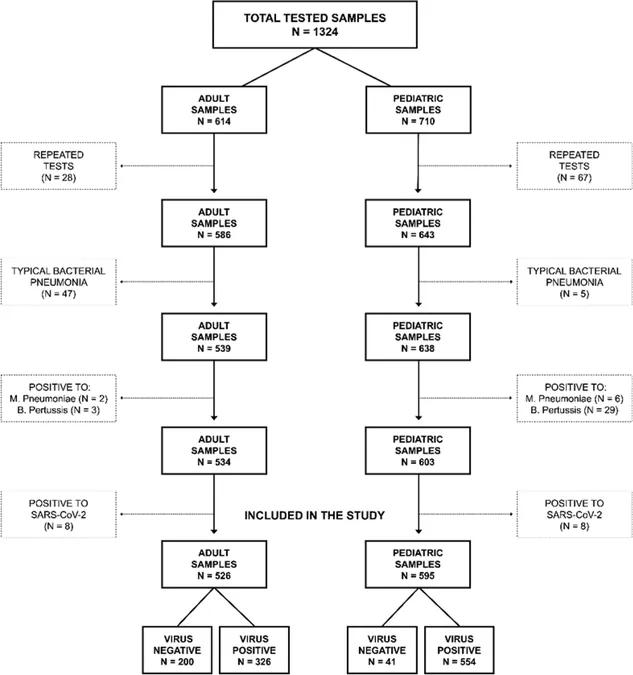
Decoding Respiratory Viral Infections: Insights on Age-Specific Patterns and Emerging Threats
2025-03-25
Author: Mei
Introduction
In a groundbreaking study conducted at Sapienza University Hospital in Rome, researchers have explored the nuances of respiratory viral infections, especially in the wake of ongoing challenges posed by emerging pathogens and seasonal viruses. Between October 2023 and June 2024, 1,324 respiratory specimens were analyzed to better understand age-specific patterns of virus prevalence and the dynamics of co-infections.
Methodology
Initially, patients across all age groups presenting symptoms of respiratory illness were tested for SARS-CoV-2 using rapid antigen tests. Those who tested negative underwent further evaluation for acute respiratory infections (ARIs), including common symptoms like cough, shortness of breath, and sore throat. Samples were sent to the hospital's specialized Microbiology and Virology Laboratory, where a meticulous diagnostic process was undertaken to identify various respiratory pathogens.
To ensure accurate data collection, repeated samples from the same patient were excluded, leading to a focused group of 1,121 patients, including a significant percentage of pediatric cases. Alarmingly, while 78.5% tested positive for respiratory viruses, others were found to be coinfected with multiple viruses—a concern for public health experts as co-infections can complicate treatment and recovery.
Findings
Among the patients, Human Rhinovirus (HRV) emerged as the most frequently detected virus, with a staggering 32.4% of positive cases attributed to it. This aligns with prior findings that HRV infections are prevalent across various age groups, particularly in children. The seasonal peak for HRV cases in 2023 coincided with increased emergency room visits, raising questions about its clinical significance as both a solo and co-infecting agent.
Interestingly, the patterns of viral infections differed significantly by age group. While Influenza A Virus (IAV) and Respiratory Syncytial Virus (RSV) were predominant in older adults and infants, respectively, the data indicated that IAV was less common in infants—where RSV reigned supreme. This suggests a targeted vulnerability in specific demographics, emphasizing the need for tailored public health responses.
Coinfection Dynamics
As the study deepened its focus on respiratory virus coinfection rates, it revealed a complex interplay among the major pathogens. Low coinfection rates between IAV and RSV were particularly noteworthy, indicating that while they both circulated during the same weeks, they may competitively inhibit each other. Conversely, HRV showed a higher incidence of co-infections, especially during the winter months, raising concerns about its potential to complicate clinical outcomes for patients infected with other illnesses.
Emerging Threats
Moreover, the analysis of viral circulation highlighted the surprising resurgence of atypical pathogens, including specific enteroviruses, in pediatric patients. Two cases of Enterovirus-C105 were identified, which have historically posed risks of severe complications in children. This reinforces the urgent need for enhanced surveillance and integrated diagnostic strategies to swiftly identify and respond to novel or mutated viruses that might pose significant public health threats.
Conclusion
With the study pointing towards a full return of respiratory viruses to their usual seasonal patterns, it is a clarion call for healthcare systems. Continuous incorporation of advanced diagnostic tools alongside epidemiological data is crucial in executing effective containment strategies and improving patient outcomes.
In summary, as we unravel the complexities of respiratory viral infections in the context of age dynamics and co-infections, it is evident that a proactive approach in monitoring viral activity can yield significant dividends in public health preparedness and response strategies. With respiratory viruses rapidly circulating in the community, understanding their interplay allows us to remain vigilant against potential outbreaks that could strain healthcare systems globally.



 Brasil (PT)
Brasil (PT)
 Canada (EN)
Canada (EN)
 Chile (ES)
Chile (ES)
 Česko (CS)
Česko (CS)
 대한민국 (KO)
대한민국 (KO)
 España (ES)
España (ES)
 France (FR)
France (FR)
 Hong Kong (EN)
Hong Kong (EN)
 Italia (IT)
Italia (IT)
 日本 (JA)
日本 (JA)
 Magyarország (HU)
Magyarország (HU)
 Norge (NO)
Norge (NO)
 Polska (PL)
Polska (PL)
 Schweiz (DE)
Schweiz (DE)
 Singapore (EN)
Singapore (EN)
 Sverige (SV)
Sverige (SV)
 Suomi (FI)
Suomi (FI)
 Türkiye (TR)
Türkiye (TR)
 الإمارات العربية المتحدة (AR)
الإمارات العربية المتحدة (AR)